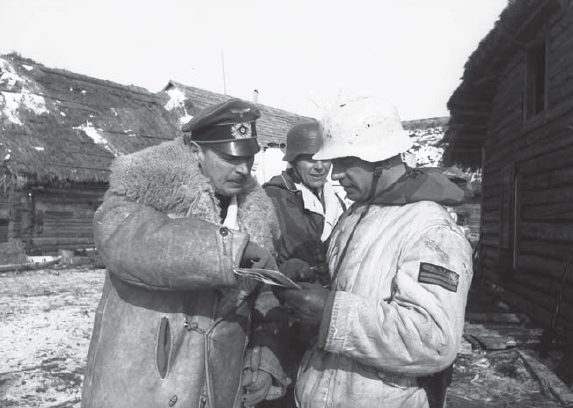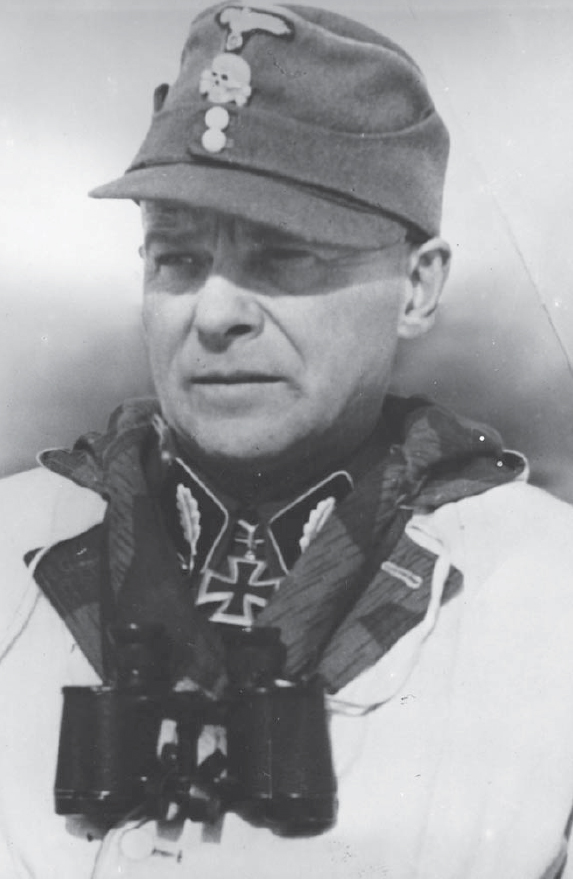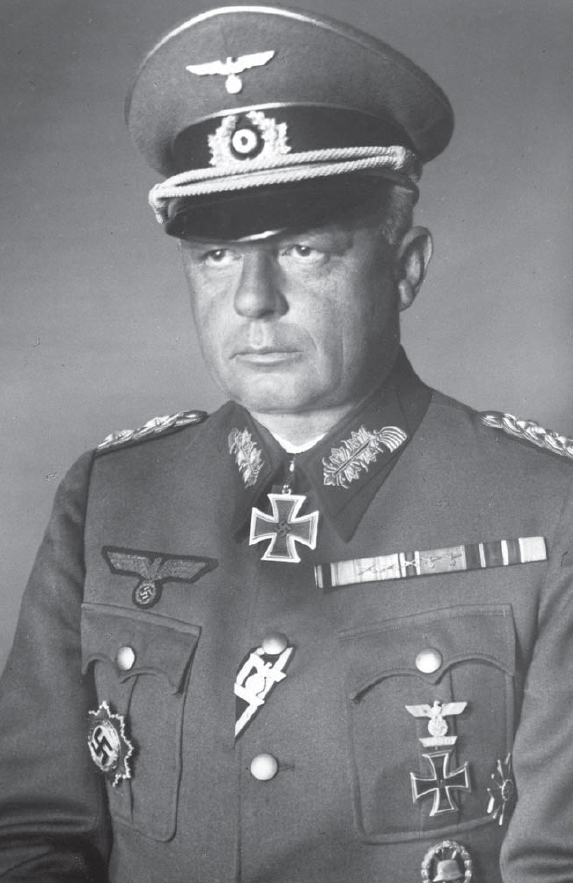Between Giants (27 page)
Authors: Prit Buttar
Tags: #Between Giants: The Battle for the Baltics in World War II

Two leading personalities of LVI Panzer Corps: Erich Brandenburger (left foreground) briefing his corps commander, Erich von Manstein (right foreground) in July 1941.

The
Panzergraf
photographed in early 1944.

One of the leading Tiger ‘aces’, Carius became a pharmacist after the war.

A former Latvian Army officer, Veiss was an early enthusiast for using the German occupation as an opportunity to drive pro-Soviet supporters from Latvia.

After commanding Army Group Narva earlier in 1944, Friessner took command of Army Group North in the summer.
The two Latvian police battalions near Leningrad were serving as part of the 2nd Motorised SS Infantry Brigade, alongside Dutch and Flemish soldiers. The brigade served with distinction both during the Soviet Operation
Iskra
(‘Spark’), which succeeded in establishing a land corridor into Leningrad, and the attacks to draw away the Germans from critical parts of the front. The Latvians were particularly heavily involved in the fighting around Siniavino. With the intention of converting the brigade into an entirely Latvian formation, Himmler ordered the Dutch and Flemish battalions transferred elsewhere, and eventually in May 1943, the unit was renamed the
2. Lettische SS-Freiwilligen Brigade
(‘2nd Latvian SS Volunteer Brigade’). Earlier, the two Latvian police battalions were pulled out of the front line at the same time as the Dutch and Flemish troops were transferred out, and in conjunction with a third battalion commenced training as the first formal units of the Latvian Legion, under the overall command of Brigadeführer Fritz von Scholtz. They were in action in March 1943 to the south-west of Leningrad, near Verkneye-Koirovo, their first battle as part of the Legion, though shortly afterwards they were once more pulled out of the front line and given new uniforms and ranks, to reflect their new designation as a regiment of the SS. A large draft of reinforcements arrived from Latvia to bring them up to strength; contrary to the agreement between Lohse and the Latvian civil administration, these men had received only a minimal amount of training before being sent to the front, and when the brigade returned to the front line along the River Volkhov in May, it was barely ready for combat. Fortunately – perhaps as a result of the trackless marshes, which earned this sector the nickname ‘The End of the World’, there was little fighting in the sector through the summer. In September, the brigade went into action to contest a hill on the southern end of its sector, and finally prevailed, after suffering heavy casualties.
22
Voldemars Veiss, who had been a Latvian army officer between the wars, was the Latvian officer who was effectively second-in-command of the brigade. He was awarded the Iron Cross during the fighting in September 1943, and in January 1944 became the first Latvian to earn the Knight’s Cross, after successfully defending Nekokhovo from repeated Soviet attacks. He was killed in April 1944 after suffering wounds from a grenade explosion.
There continued to be friction between the Germans and Latvians. In addition to the 2nd SS Brigade, efforts were made to convert the Latvian Legion into a new formation, 15th SS Waffen-Grenadier Division (1st Latvian), in March 1943. The Latvians complained that there were insufficient NCOs and officers for this new division, and that attempts to bring it up to strength were constantly undermined by the transfer of troops to the 2nd SS Brigade. The division was also hampered by shortages of equipment; in some cases, men were issued with weapons that were different from those that they had used in their often inadequate training. In November 1943, even though the division was, in the opinion of its officers, not ready for combat, it was committed to the front line near Leningrad, and performed well in defensive fighting. Some battalions of the division were assigned to
ad hoc
battlegroups, as was normal practice in the Wehrmacht, and on many occasions, the German units in the battlegroups seized the new machine guns and other equipment of the Latvians, further adding to the tension between the two sides.
Towards the end of 1943, it was decided to upgrade the 2nd SS Brigade into a division. Designated the 19th SS Waffen-Grenadier Division (2nd Latvian), it was created in January 1944. As will be discussed later, it soon found itself in the thick of the fighting to the south of Leningrad.
Of the three countries, Lithuania provided the smallest military contingent to the German cause. Initially, the country’s classification as being the least ‘worthy’ of the three countries – its population was largely Catholic, and was perceived by the National Socialist leadership as heavily tainted with Polish and Slav blood – meant that there was little question of Lithuanians being asked to serve in the Reich’s armed forces. It was only as the war situation began to deteriorate, and Germany was desperate for manpower, that the issue was revisited. By then, there was even less enthusiasm than ever amongst Lithuanians to fight for Germany.
During the German occupation, the Lithuanian police formed a total of 25 battalions. These units should be distinguished from regular police units in towns and cities; they existed specifically for internal security purposes, such as protecting military installations and combating insurgents and partisans. The first battalions were formed from the Lithuanian Activist Front volunteers who fought the retreating Red Army in Kaunas, and from Lithuanians who deserted from the Red Army; these men came primarily from the Soviet 29th Corps, and were based in and around Varėna. At first, it had been the intention of the Lithuanians to organise these men into a fledgling army, but the Germans refused to allow this to happen, and on 9 July 1941, most of the units that had been given provisional army names were renamed
Selbstschutzeinheiten
(‘self defence units’). Over the next few years, the battalions went through a variety of name changes before they were finally given the title ‘police battalions’.
One of the first units to be formed was the
Tautos Darbo Apsauga
(‘National Labour Service Battalion’ or TDA) in Kaunas. Colonel Jurgis Bobelis, who had been appointed by the self-proclaimed Lithuanian interim government, called for volunteers to come forward on 28 June 1941, and by 4 July he had over 700 men at his disposal. Two companies were immediately assigned to
Einsatzkommando 3A
at Fort VII. One company was tasked with guarding the Jews who were brought there in a steady stream, while the other company carried out the executions, under German supervision. As the killings continued, both in Kaunas and through the activities of Hammann’s
Rollkommando
, almost all of the personnel of the TDA were directly involved.
23
The reaction of the Lithuanian soldiers to their gruesome tasks was varied. One of the junior officers of the battalion was Lieutenant Juozas Barzda, who had been a member of the Lithuanian Army prior to the Soviet occupation. He commanded 3 Company of the TDA, and was involved in several of the major massacres of Jews during 1941. He also took part in killings of Jews and Soviet prisoners in Belarus, but by 1944, he had joined the
Lietuvos Laisvės Armija
(‘Lithuanian Freedom Army’ or LLA), fighting against the returning Red Army. He was killed in December 1944 when, while taking part in a parachute drop, he drowned in a lake. Bronius Norkius, a former air force officer, was also a lieutenant in the TDA. He achieved fame for raising the Lithuanian flag over Kaunas Cathedral on 23 June 1941, but like Barzda he was implicated in many of the killings in that year. He died in an accident in the Soviet Union in 1943. A third lieutenant, Anatolijus Dagys, was also a member of 3 Company, and like the other two was noted to perform with distinction during the mass executions of Jews.
24
It is characteristic of the ambiguity with which many in Lithuania regard their past that in view of Norkius’ act of defiance of the Soviet authorities in June 1941, his grave has been proposed as a national monument, despite his involvement in the killings later that year.
Other members of the TDA were shocked and demoralised by what they were required to do. Many requested permission to leave the battalion, and by 11 July 1941, less than two weeks after the establishment of the TDA, 117 men had been discharged. Captain Bronius Kirkila, commander of 1 Company, committed suicide on 12 July, and a steady stream of men simply deserted. Four of the battalion’s lieutenants submitted their resignations and were dismissed.
25
None of these events had the slightest effect on the pace of the killings.
The 2nd Lithuanian Police Battalion, confusingly later renamed as the 12th Battalion, was formed on 7 August 1941 under the command of Major Antanas Impelivičius, using a cadre of men from the TDA. At first, the battalion was stationed at the Šančiai Barracks in Kaunas, and was responsible for guard duties, but in October, under the supervision of the German Major Lechthaler, it moved to Minsk. Here, working in cooperation with 707th Infantry Division, it was responsible for pacification. The commander of 707th Infantry Division, Generalmajor Gustav
Freiherr
von Bechtolsheim, later reported that the Lithuanians helped his men execute 630 ‘suspicious elements’ in the second week of October – mainly those deemed to be communists or Jews – and were also involved in the killing of about 1,300 people in the nearby towns of Kliniki and Smilovichi.
26
By the end of the month, with help from elements of
Einsatzkommando 3
and the German personnel that had accompanied its deployment from Kaunas, the Lithuanian 2nd Police Battalion had killed over 14,000 people.
27
The killings of Jews in the town of Sluck shocked even the local German military. The local commandant wrote to Minsk in protest:
Referring to the ways of performing the operation, I had to regret that it equalled to sadism. The town itself looked horrible during the operation. Indescribably cruel German police officers, and particularly the Lithuanian partisans, forced the Jews, including Belarusians, out of their homes and pushed them into one place. Firing was heard throughout the town, and in certain streets piles of the Jewish victims appeared … protect me from this police battalion in future!
28
